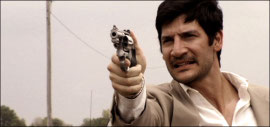 THE BRIDE WORE BLOOD
THE BRIDE WORE BLOOD
Audiences who attend the latest film by Bluebox Limited's Scott Beck and Bryan Woods - a contemporary western entitled The Bride Wore Blood - should be thrilled for the chance to see it at Davenport's Putnam Museum & IMAX Theatre. (Having recently won Best Feature, Best Director, and three additional awards at Iowa's Wild Rose Independent Film Festival, the movie makes its area debut on November 11.) The local directors/writers/producers - both of whom, at age 22, seem almost preternaturally gifted - make spectacular use of space and sound, and the film's IMAX presentation lends the work deserved grandeur; it's a fittingly huge venue for Beck's and Woods' talents.
But when you get the chance, see the movie again, watch the cat-and-mouse sequence between the two bounty hunters, and then tell me: How did they do that?
The scene I'm referring to arrives about halfway through the movie. Our protagonist, known only as The Hired Gun (Travis Shepherd), has been employed to protect The Bride (Christy Sullivan), whose husband (Shane Simmons) believes she may be in mortal danger. Yet tragedy ensues, and The Hired Gun - who, it's suggested, may be in love with his charge - finds himself stalking Jack Lavine (Jim Siokos), a fellow bounty hunter, in his suburban home. (In The Bride Wore Blood's prologue, they're actually referred to as "bounty killers.")
As the men encircle one another, Beck's and Woods' camera glides along the main floor of the house, and the escalating tension is remarkably well-sustained; only a handful of Hollywood films this year have achieved a similar effect. Yet at the end of their edgy pas de deux, The Hired Gun walks through an empty living room, stops in close-up, and the camera, without breaking the shot, pans just slightly to the right - and there, standing behind him, is Jack Levine.
Watching that moment at the Putnam was thrilling, to be sure, but seeing it again later on a DVD screener was astounding - where the hell did Levine come from? There's nothing remotely self-conscious about the trick, and the grace with which it's staged is incredible; I rewound the sequence three times to try to figure out how Beck and Woods pulled it off, and still have no idea.
I reference the moment not merely because it's one of many highlights in The Bride Wore Blood, but because it underscores the natural ease and fluidity of Beck's and Woods' style. Their shots here are dramatic without calling attention to the composition, and the measured, confident tone of the movie is revealed in the unbroken takes and lingering dread; you feel the co-directors getting exactly the effects they're shooting for. Unlike many young filmmakers, the Bluebox impresarios aren't showing off their talents here - they're just showing them.
In The Bride Wore Blood, they're also showing a talent for inventive narrative structure. As The Hired Gun begins to uncover The Bride's true nature, and that of those who may want her dead, flashbacks and chronological detours lead to further levels of deception and gamesmanship; not until the final, fatalistic shot will the story be explained in full. This cinematic-puzzle style can easily lead to incoherence, but Beck and Woods always keep the plotting lucid. (It helps, of course, that there are fewer than 10 characters to keep track of in the film.)
They also pepper the storytelling with shots so assured they nearly give you the giggles: a gradual, 180-degree reveal of The Hired Gun's truck during a railroad-track rendezvous, a close-up into a burning wastebasket suggesting a "professional's" descent into hell. At just under an hour, The Bride Wore Black is suffused with memorable images and impressive visuals.
I'd argue that it might have been better at just under 50 minutes. Bride's style is partly an homage to Sergio Leone's spaghetti westerns - featuring appropriate, magnificent spaghetti-western music by Scott Morschhauser, whose band, the Metrolites, provides a great, funky title theme - and so it requires long takes. But a few are too long.
At one point, The Hired Gun watches a man attempt to mow his lawn, and at three minutes the scene goes from torpid (because nothing's happening) to funny (because the procrastination begins to feel like a joke) and back to torpid again (because you realize it probably isn't one.) Similarly, an early encounter between The Hired Gun and Levine features too many shots of the killers staring one another down; although Morschhauser's score gives the scene some comic context, the preamble to this potential shoot-out continues for about 10 seconds longer than it needs to. (Considering the strength of the individual shots, though, you can understand why Beck and Woods may have been reluctant to yell "Cut!")
The cast does a fine job of acting inscrutable, yet plays so close to the vest that you may wish for more performance fireworks than you get. Justin Marxen, though, lends heartfelt vigor to his conflicted cop, and the film is stolen early on by Casey Campbell, who tears through a monologue about "ugly chicks" and his unapologetic self-infatuation; Campbell gives his brief role an electric charge reminiscent of Peter Sarsgaard in contemptuous-scumbag mode.
Beck and Woods manage to make the actor's scene captivating without extraneous movement, nerve-racking through silence, and - with Campbell devouring fried chicken on a pristine dining room table - funny without telegraphing or pandering. The Bride Wore Blood showcases true talent, and perhaps the filmmakers' most amazing accomplishment is that, as they reveal, their latest work only cost about $600 to make.
How did they do that?
The Bride Wore Blood will make its area debut at the Putnam Museum & IMAX Theatre at 7:30 p.m. on Saturday, November 11. For tickets, call (563) 324-1933. For more information about the film, visit TheBrideWoreBlood.com.










